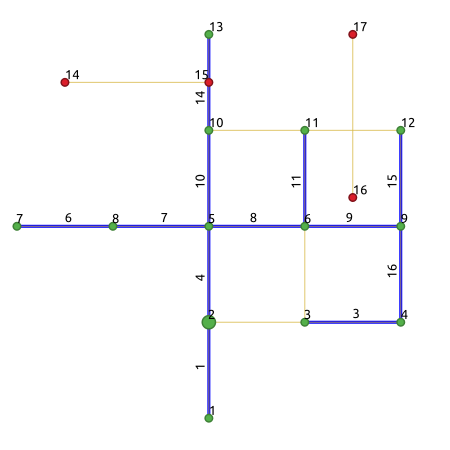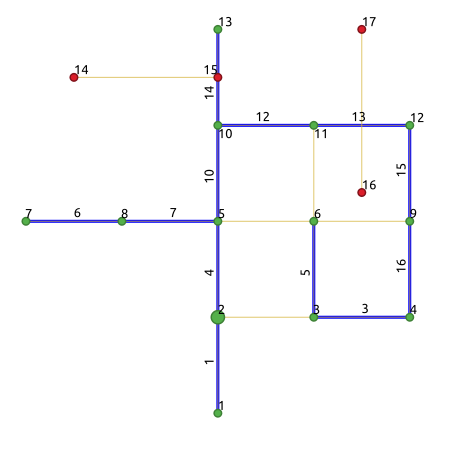pgr_depthFirstSearch - Experimental¶
pgr_depthFirstSearch — Returns a depth first search traversal of the graph.
The graph can be directed or undirected.

Boost Graph Inside¶
Warning
Possible server crash
These functions might create a server crash
Warning
Experimental functions
They are not officially of the current release.
They likely will not be officially be part of the next release:
The functions might not make use of ANY-INTEGER and ANY-NUMERICAL
Name might change.
Signature might change.
Functionality might change.
pgTap tests might be missing.
Might need c/c++ coding.
May lack documentation.
Documentation if any might need to be rewritten.
Documentation examples might need to be automatically generated.
Might need a lot of feedback from the comunity.
Might depend on a proposed function of pgRouting
Might depend on a deprecated function of pgRouting
Availability
Version 3.2.0
New experimental function
Description¶
Depth First Search algorithm is a traversal algorithm which starts from a root vertex, goes as deep as possible, and backtracks once a vertex is reached with no adjacent vertices or with all visited adjacent vertices. The traversal continues until all the vertices reachable from the root vertex are visited.
The main Characteristics are:
The implementation works for both directed and undirected graphs.
Provides the Depth First Search traversal order from a root vertex or from a set of root vertices.
An optional non-negative maximum depth parameter to limit the results up to a particular depth.
For optimization purposes, any duplicated values in the Root vids are ignored.
It does not produce the shortest path from a root vertex to a target vertex.
The aggregate cost of traversal is not guaranteed to be minimal.
The returned values are ordered in ascending order of start_vid.
Depth First Search Running time:
Signatures¶
Summary
pgr_depthFirstSearch(Edges SQL, Root vid [, directed] [, max_depth]) -- Experimental on v3.2
pgr_depthFirstSearch(Edges SQL, Root vids [, directed] [, max_depth]) -- Experimental on v3.2
RETURNS SET OF (seq, depth, start_vid, node, edge, cost, agg_cost)
Using defaults
- Example
From root vertex
SELECT * FROM pgr_depthFirstSearch(
'SELECT id, source, target, cost, reverse_cost FROM edge_table
ORDER BY id',
2
);
seq | depth | start_vid | node | edge | cost | agg_cost
-----+-------+-----------+------+------+------+----------
1 | 0 | 2 | 2 | -1 | 0 | 0
2 | 1 | 2 | 1 | 1 | 1 | 1
3 | 1 | 2 | 5 | 4 | 1 | 1
4 | 2 | 2 | 8 | 7 | 1 | 2
5 | 3 | 2 | 7 | 6 | 1 | 3
6 | 2 | 2 | 6 | 8 | 1 | 2
7 | 3 | 2 | 9 | 9 | 1 | 3
8 | 4 | 2 | 12 | 15 | 1 | 4
9 | 4 | 2 | 4 | 16 | 1 | 4
10 | 5 | 2 | 3 | 3 | 1 | 5
11 | 3 | 2 | 11 | 11 | 1 | 3
12 | 2 | 2 | 10 | 10 | 1 | 2
13 | 3 | 2 | 13 | 14 | 1 | 3
(13 rows)
Single vertex¶
pgr_depthFirstSearch(Edges SQL, Root vid [, directed] [, max_depth])
RETURNS SET OF (seq, depth, start_vid, node, edge, cost, agg_cost)
- Example
From root vertex
SELECT * FROM pgr_depthFirstSearch(
'SELECT id, source, target, cost, reverse_cost FROM edge_table
ORDER BY id',
2, directed => false, max_depth => 2
);
seq | depth | start_vid | node | edge | cost | agg_cost
-----+-------+-----------+------+------+------+----------
1 | 0 | 2 | 2 | -1 | 0 | 0
2 | 1 | 2 | 1 | 1 | 1 | 1
3 | 1 | 2 | 3 | 2 | 1 | 1
4 | 2 | 2 | 4 | 3 | 1 | 2
5 | 2 | 2 | 6 | 5 | 1 | 2
6 | 1 | 2 | 5 | 4 | 1 | 1
7 | 2 | 2 | 8 | 7 | 1 | 2
8 | 2 | 2 | 10 | 10 | 1 | 2
(8 rows)
Multiple vertices¶
pgr_depthFirstSearch(Edges SQL, Root vids [, directed] [, max_depth])
RETURNS SET OF (seq, depth, start_vid, node, edge, cost, agg_cost)
- Example
From root vertices
SELECT * FROM pgr_depthFirstSearch(
'SELECT id, source, target, cost, reverse_cost FROM edge_table
ORDER BY id',
ARRAY[11, 2], directed => false, max_depth => 2
);
seq | depth | start_vid | node | edge | cost | agg_cost
-----+-------+-----------+------+------+------+----------
1 | 0 | 2 | 2 | -1 | 0 | 0
2 | 1 | 2 | 1 | 1 | 1 | 1
3 | 1 | 2 | 3 | 2 | 1 | 1
4 | 2 | 2 | 4 | 3 | 1 | 2
5 | 2 | 2 | 6 | 5 | 1 | 2
6 | 1 | 2 | 5 | 4 | 1 | 1
7 | 2 | 2 | 8 | 7 | 1 | 2
8 | 2 | 2 | 10 | 10 | 1 | 2
9 | 0 | 11 | 11 | -1 | 0 | 0
10 | 1 | 11 | 6 | 11 | 1 | 1
11 | 2 | 11 | 3 | 5 | 1 | 2
12 | 2 | 11 | 5 | 8 | 1 | 2
13 | 2 | 11 | 9 | 9 | 1 | 2
14 | 1 | 11 | 10 | 12 | 1 | 1
15 | 2 | 11 | 13 | 14 | 1 | 2
16 | 1 | 11 | 12 | 13 | 1 | 1
(16 rows)
Parameters¶
Parameter |
Type |
Description |
|---|---|---|
Edges SQL |
|
SQL query described in Inner query. |
Root vid |
|
Identifier of the root vertex of the tree.
|
Root vids |
|
Array of identifiers of the root vertices.
|
Optional Parameters¶
Parameter |
Type |
Default |
Description |
|---|---|---|---|
directed |
|
|
|
max_depth |
|
Upper limit for the depth of traversal
|
Inner query¶
Edges SQL
Column |
Type |
Default |
Description |
|---|---|---|---|
id |
|
Identifier of the edge. |
|
source |
|
Identifier of the first end point vertex of the edge. |
|
target |
|
Identifier of the second end point vertex of the edge. |
|
cost |
|
|
|
reverse_cost |
|
-1 |
|
Where:
- ANY-INTEGER
SMALLINT, INTEGER, BIGINT
- ANY-NUMERICAL
SMALLINT, INTEGER, BIGINT, REAL, FLOAT
Result Columns¶
Returns SET OF (seq, depth, start_vid, node, edge, cost, agg_cost)
Column |
Type |
Description |
|---|---|---|
seq |
|
Sequential value starting from |
depth |
|
Depth of the
|
start_vid |
|
Identifier of the root vertex.
|
node |
|
Identifier of |
edge |
|
Identifier of the
|
cost |
|
Cost to traverse |
agg_cost |
|
Aggregate cost from |
Additional Examples¶
The examples of this section are based on the Sample Data network.
Example: No internal ordering on traversal
In the following query, the inner query of the example: “Using defaults” is modified so that the data is entered into the algorithm is given in the reverse ordering of the id.
SELECT * FROM pgr_depthFirstSearch(
'SELECT id, source, target, cost, reverse_cost FROM edge_table
ORDER BY id DESC',
2
);
seq | depth | start_vid | node | edge | cost | agg_cost
-----+-------+-----------+------+------+------+----------
1 | 0 | 2 | 2 | -1 | 0 | 0
2 | 1 | 2 | 5 | 4 | 1 | 1
3 | 2 | 2 | 10 | 10 | 1 | 2
4 | 3 | 2 | 13 | 14 | 1 | 3
5 | 3 | 2 | 11 | 12 | 1 | 3
6 | 4 | 2 | 12 | 13 | 1 | 4
7 | 5 | 2 | 9 | 15 | 1 | 5
8 | 6 | 2 | 4 | 16 | 1 | 6
9 | 7 | 2 | 3 | 3 | 1 | 7
10 | 8 | 2 | 6 | 5 | 1 | 8
11 | 2 | 2 | 8 | 7 | 1 | 2
12 | 3 | 2 | 7 | 6 | 1 | 3
13 | 1 | 2 | 1 | 1 | 1 | 1
(13 rows)
The resulting traversal is different.
The left image shows the result with ascending order of ids and the right image shows with descending order of ids:
See Also¶
The queries use the Sample Data network.
Indices and tables


